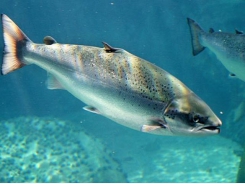Fish disease guide - Infectious Haematopoietic Necrosis (IHN)

What Is It?
Infectious haematopoietic necrosis (IHN) is an infectious viral disease of salmon and trout. It was first recognised in the 1950s in sockeye and chinook salmon. The disease has most economic significance for freshwater farms, however Pacific and Atlantic salmon (Salmo salar L.) in both fresh and sea water have been severely affected.
Where and When it Might Occur?
IHN virus spread across North America in the 1970s in rainbow trout (Oncorhynchus mykiss), apparently originating from fry or egg shipments from a single source. The virus was also introduced to Japan in 1968 by eggs from Alaska and has since spread to continental Europe, although it has never been detected in British waters.
Most if not all salmonid species are susceptible to the virus, with fry and small fingerlings becoming infected very readily, and becoming more resistant as they mature. The infection is often lethal and the mortality rate can be 100% in fry. Those fish that survive an outbreak of IHN can become carriers of the virus, providing a reservoir of infection. In addition, infected juveniles will shed IHN virus particles in the faeces, urine and external mucus.
Diagnosis
The visible signs of the disease are lethargic fish showing occasional bouts of abnormally frenzied activity that usually precedes death. The external surface of the fish appears exophthalmic and dark, with pale gills and haemorrhaging at the base of the fins. The abdomen is often swollen, eyes may be protruding and a long opaque pseudocast can be seen trailing from the vent. Internally, the fish will appear generally anaemic, with a mucus-like fluid found instead of food in the digestive tract. Additionally, ascitic fluid can be found in the body cavity.
The causative agent of IHN is a rhabdovirus of the genus novirhabdovirus, known as IHN virus (IHNV). IHNV can be isolated from spawning fish, from the pyloric caeca, intestine and ovarian/seminal fluid, and is thought to replicate in the endothelial cells of blood vessels, haematopoietic tissues and nephron cells.
Virus is isolated in cell culture from the internal organs of the fish and identification is confirmed by enzyme-linked immunosorbent assay (ELISA), indirect fluorescent antibody tests (IFAT), polymerase chain reaction (PCR) or antibody neutralisation assays.
Control
IHNV can be transmitted through water, by movement of fish, contact with contaminated untreated waste material and by equipment. In areas where IHN is endemic, the number of cases can be controlled by good hygiene, the use of virus-free water supplies and the disinfection of eggs from farms with IHNV. Testing of brood stock is important in identifying carriers; where known carriers are present, the disinfection of eggs with iodine products is recommended.
IHN is a notifiable diseases under the Diseases of Fish Act and is a List II disease under European Directive 91/67/EEC. Great Britain is an approved zone for IHN, and to maintain this status all farms holding susceptible species of fish are inspected at least once a year. In addition, at least once every two years samples of internal organs (and ovarian fluid in the case of broodstock) are taken from 30 fish and tested for the presence of the virus.
Có thể bạn quan tâm
Phần mềm

Phối trộn thức ăn chăn nuôi

Pha dung dịch thủy canh

Định mức cho tôm ăn

Phối trộn phân bón NPK

Xác định tỷ lệ tôm sống

Chuyển đổi đơn vị phân bón

Xác định công suất sục khí

Chuyển đổi đơn vị tôm

Tính diện tích nhà kính

Tính thể tích ao hồ



 Fish disease guide - Infection with Infectious Spleen…
Fish disease guide - Infection with Infectious Spleen…  Cutting aquaponics costs is more than pot luck
Cutting aquaponics costs is more than pot luck